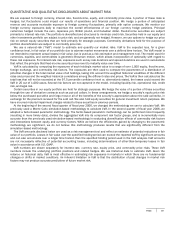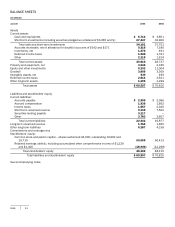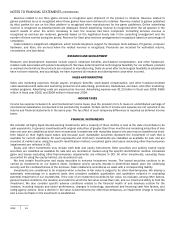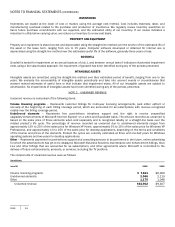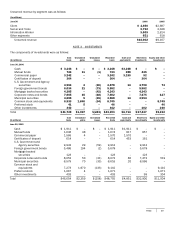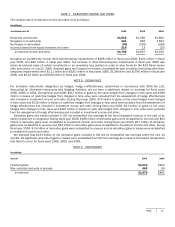Microsoft 2006 Annual Report Download - page 47
Download and view the complete annual report
Please find page 47 of the 2006 Microsoft annual report below. You can navigate through the pages in the report by either clicking on the pages listed below, or by using the keyword search tool below to find specific information within the annual report.
PAGE 46
NOTES TO FINANCIAL STATEMENTS (CONTINUED)
Revenue related to our Xbox game console is recognized upon shipment of the product to retailers. Revenue related to
games published by us is recognized when those games have been delivered to retailers. Revenue related to games published
by third parties for use on the Xbox platform is recognized when manufactured for the game publishers. Online advertising
revenue is recognized as advertisements are displayed. Search advertising revenue is recognized when the ad appears in the
search results or when the action necessary to earn the revenue has been completed. Consulting services revenue is
recognized as services are rendered, generally based on the negotiated hourly rate in the consulting arrangement and the
number of hours worked during the period. Revenue for fixed price services arrangements is recognized based on percentage of
completion.
Costs related to insignificant obligations, which include telephone support for developer tools software, PC games, computer
hardware, and Xbox, are accrued when the related revenue is recognized. Provisions are recorded for estimated returns,
concessions, and bad debts.
RESEARCH AND DEVELOPMENT
Research and development expenses include payroll, employee benefits, stock-based compensation, and other headcount-
related costs associated with product development. We have determined that technological feasibility for our software products
is reached shortly before the products are released to manufacturing. Costs incurred after technological feasibility is established
have not been material, and accordingly, we have expensed all research and development costs when incurred.
SALES AND MARKETING
Sales and marketing expenses include payroll, employee benefits, stock-based compensation, and other headcount-related
costs associated with sales and marketing personnel and advertising, promotions, tradeshows, seminars, and other marketing-
related programs. Advertising costs are expensed as incurred. Advertising expense was $1.23 billion in fiscal year 2006, $995
million in fiscal year 2005, and $904 million in fiscal year 2004.
INCOME TAXES
Income tax expense includes U.S. and international income taxes, plus the provision for U.S. taxes on undistributed earnings of
international subsidiaries not deemed to be permanently invested. Certain items of income and expense are not reported in tax
returns and financial statements in the same year. The tax effect of such temporary differences is reported as deferred income
taxes.
FINANCIAL INSTRUMENTS
We consider all highly liquid interest-earning investments with a maturity of three months or less at the date of purchase to be
cash equivalents. In general, investments with original maturities of greater than three months and remaining maturities of less
than one year are classified as short term investments. Investments with maturities beyond one year may be classified as short-
term based on their highly liquid nature and because such marketable securities represent the investment of cash that is
available for current operations. All cash equivalents and short-term investments are classified as available for sale and are
recorded at market value using the specific identification method; unrealized gains and losses (excluding other-than-temporary
impairments) are reflected in OCI.
Equity and other investments may include both debt and equity instruments. Debt securities and publicly traded equity
securities are classified as available for sale and are recorded at market using the specific identification method. Unrealized
gains and losses (excluding other-than-temporary impairments) are reflected in OCI. All other investments, excluding those
accounted for using the equity method, are recorded at cost.
We lend certain fixed-income and equity securities to enhance investment income. The loaned securities continue to be
carried as investments on our balance sheet. Collateral and/or security interest is determined based upon the underlying
security and the creditworthiness of the borrower. Cash collateral is recorded as an asset with a corresponding liability.
Investments are considered to be impaired when a decline in fair value is judged to be other-than-temporary. We employ a
systematic methodology on a quarterly basis that considers available quantitative and qualitative evidence in evaluating
potential impairment of our investments. If the cost of an investment exceeds its fair value, we evaluate, among other factors,
general market conditions, the duration and extent to which the fair value is less than cost, and our intent and ability to hold the
investment. We also consider specific adverse conditions related to the financial health of and business outlook for the
investee, including industry and sector performance, changes in technology, operational and financing cash flow factors, and
rating agency actions. Once a decline in fair value is determined to be other-than-temporary, an impairment charge is recorded
and a new cost basis in the investment is established.





